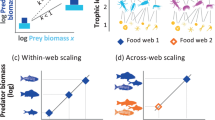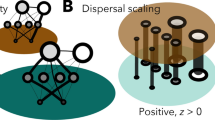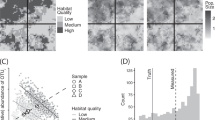Abstract
Although Camacho and Arenas1 raise potentially interesting points, we believe that some of their arguments are flawed or undermined by poor statistics, and therefore that they do not invalidate our results2.
Similar content being viewed by others
Main
Even though the two limiting curves shown in their Fig. 1a for three-level food webs define a ‘narrow’ region1, several power laws can be drawn between them. The authors show for the randomized St Marks web (their Fig. 1b) that different distributions of species between levels yield different exponents, but they do not explain why the empirical web should display the particular value η=1.18, which is only one of its allowed values. Moreover, as the (A0, C0) points in Fig. 1b are the most affected by the randomization, the allowed range for the C0 versus A0 curve in Fig. 1c must be even wider. In our opinion, the claim of Camacho and Arenas1 that the observed values of η (including that for the C0 versus A0 curve) are due merely to the number of trophic levels is incorrect.
This means that our claim that allometric scaling adds information on food-web structure still stands, in particular with regard to the distribution of species between levels: for example, the distribution (6–31–11) for the real St Marks web is ‘in between’ two of the randomized distributions (4–40–4 and 16–16–16) considered in Fig. 1b of Camacho and Arenas1, and so the observed value (η=1.18) lies between those for the two randomizations (η=1.15, η=1.19), but far from the other values. Randomized webs must therefore be forced to have a distribution of species between levels very similar to the empirical one in order to display (approximately) the same exponent.
What is more interesting is the broader range of exponents measured by Camacho and Arenas, suggesting that our results might be subject to variation if different webs are considered. However, we believe that the statistics are not strong enough for new conclusions to be drawn. The discrepancy between our results for some webs highlights the extreme sensitivity of η to small variations in the data, such as the presence or absence of even a single link, which can significantly affect the trophic-level structure.
The reason for this sensitivity is the small size of food webs, which is known to obscure the assessment of various other properties, such as the clustering coefficient and the degree distribution3. In this situation, the large-scale behaviour is best captured by the C0 versus A0 curve (Fig. 1c in ref. 1). However, equation (1) of Camacho and Arenas1 shows that, for i=0, the leading term is C0∝A0d0, implying that, for the sublinear trend (η=0.97) to hold, d0 should decrease with the number of species. This is an unrealistic situation, again due to the small size of the webs, confirming that the statistics still yield no reliable result.
In the absence of data for larger webs, we can address only the expected dependence of d0 on A0 (or, equivalently, on N). In real webs3, d0 is always very similar to the average distance lav, which was shown4 to scale as lav∝ln (N) in empirical and model webs (including many of those considered by Camacho and Arenas). Then their equation (1) indicates that C0∝A0ln(A0), a curve that could be used as an alternative fit to the plots shown by Camacho and Arenas and by us; this corresponds to a different ‘universality class’, defined by the formal limit of infinite dimension D (logarithmic corrections naturally arise in such a limit) and representing an even more efficient topology.
Alternatively, it is possible — given that chain-length minimization reflects minimization of energy dissipation2 — that d0 is also related to the length lopt of the optimal minimum-dissipation chain5. Depending on the system details, lopt scales as ln(N), as N1/3, or as a more general power law5.
The claims of Camacho and Arenas are therefore entirely based on the assumption that d0 remains fixed as N increases, which in our view is an unrealistic hypothesis that disregards the wide range of possibilities described here.
References
Camacho, J. & Arenas, A. Nature 435, doi:10.1038/nature03839 (2005). | Article |
Garlaschelli, D., Caldarelli, D. & Pietronero, L. Nature 423, 165–168 (2003).
Williams, R. J., Berlow, E. L., Dunne, J. A. & Barabási, A. -L. Proc. Natl Acad. Sci. USA 99, 12913–12916 (2002).
Camacho, J., Guimerà, R. & Amaral, L. A. N. Phys. Rev. Lett. 88, 228102 (2002).
Braunstein, L. A., Buldyrev, S. V., Cohen, R., Havlin, S. & Stanley, H. E. Phys. Rev. Lett. 91, 168701 (2003).
Author information
Authors and Affiliations
Corresponding author
Rights and permissions
About this article
Cite this article
Garlaschelli, D., Caldarelli, G. & Pietronero, L. Universal scaling in food-web structure? (reply). Nature 435, E4 (2005). https://doi.org/10.1038/nature03840
Published:
Issue Date:
DOI: https://doi.org/10.1038/nature03840
Comments
By submitting a comment you agree to abide by our Terms and Community Guidelines. If you find something abusive or that does not comply with our terms or guidelines please flag it as inappropriate.



